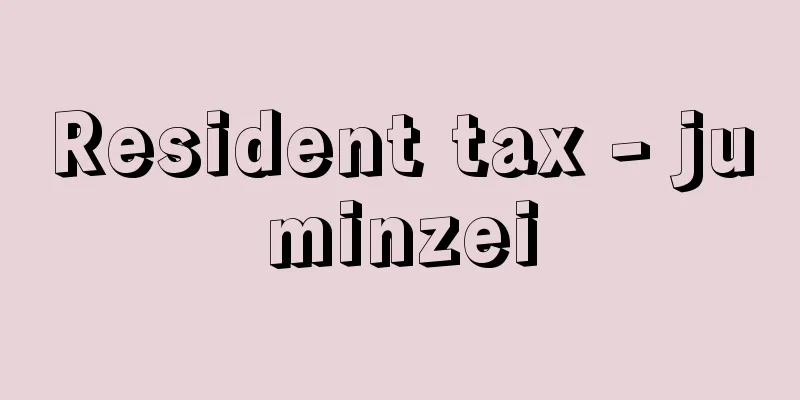Resident tax - juminzei

|
This is the combined term for prefectural inhabitant tax and municipal inhabitant tax (in the special wards of Tokyo, it is called metropolitan inhabitant tax and special ward inhabitant tax). It is a tax levied by prefectures and municipalities on individuals and corporations that have addresses or offices within their areas, with the inhabitant tax levied on individuals being called individual inhabitant tax and the inhabitant tax levied on corporations being called corporate inhabitant tax (however, in special wards, corporate inhabitant tax is levied by the metropolitan government). Resident tax consists of a flat-rate and income-rate tax, while corporate inhabitant tax consists of a flat-rate and corporate tax-rate tax. Prefectural inhabitant tax is one of the core taxes in prefectures, along with business tax, and municipal inhabitant tax, along with property tax, accounts for a large proportion of municipal taxes. [Takeshi Okawa] HistoryThe origin of the inhabitant tax was the prefectural tax per household in 1878 (Meiji 11). In 1883, the Municipal System was promulgated, which allowed municipalities to impose additional taxes on the prefectural tax per household. The prefectural tax per household was transferred to municipalities in 1926 (Taisho 15), and the per household tax became an independent municipal tax. Furthermore, the per household tax was abolished in the tax reform of 1940 (Showa 15), and municipal inhabitant taxes were established in its place. After the Second World War, the prefectural inhabitant tax was established in 1946 (Showa 21), but the tax reform of 1950 based on the Shoup recommendation abolished the prefectural inhabitant tax and municipal inhabitant tax, and the current municipal inhabitant tax was established (initially, only a flat rate was levied on corporations, but from the following year, 1951, a corporate tax rate was also levied). Furthermore, in 1954, a part of the municipal inhabitant tax was set aside to establish the prefectural inhabitant tax. Since then, changes have been made to the tax system and other aspects, and the system has continued to exist to this day. [Takeshi Okawa] Current systemThe taxpayers of resident tax are as shown in . However, the following persons are not liable for resident tax. [1] Individuals: (1) Those who had no income during the previous year, (2) Those receiving livelihood assistance under the provisions of the Public Assistance Law, (3) Disabled persons, minors, elderly persons, and widows whose income during the previous year was 1 million yen or less. (The following persons are exempt from the flat-rate tax: (1) Those who are liable to pay only the flat-rate tax and whose income during the previous year was below the amount specified by municipal ordinance, (2) A wife who lives with her husband who is liable to pay the flat-rate tax.) [2] Corporations, etc. (1) The state, local governments, the Japan Scholarship Foundation, and other public corporations to a certain extent; (2) The Japanese Red Cross Society, social welfare corporations, religious corporations, school corporations, and other public interest corporations to a certain extent (however, they are only liable to pay tax if they conduct profit-making activities). The tax base for the income tax rate is the total income amount for the previous year, retirement income amount (excluding those related to separate taxation), and forest income amount after taking basic deductions, spouse deductions, dependent deductions, and other income deductions. The tax base for the corporate tax rate is the amount of corporation tax, which is a national tax (before tax deductions under the Corporation Tax Law and the Special Taxation Measures Law). The income tax rate is a tax levied on income like the income tax, but because it is a tax levied with the intention of widely sharing the burden among residents, the minimum taxable amount (the limit below which people with incomes below which they are not taxed) is set lower than that of the income tax. It is explained that the reason why the flat-rate tax rate for individuals is divided according to the population stage is that the level of administrative capacity differs depending on the size of the population, and the purpose is to require tax burdens that correspond to that level. For income tax purposes, there are dividend deductions and foreign tax deductions as tax deductions. In addition, there are special tax treatments for retirement income, interest/dividend income, capital gains, etc. There are two methods for collecting individual inhabitant taxes: ordinary collection for general taxpayers and special collection for salaried workers (similar to the method of withholding income tax). In addition, corporate inhabitant taxes are collected by self-reporting. [Takeshi Okawa] IssuesProblems that have been pointed out regarding the resident tax include the following: the minimum taxable amount for the income tax is lower than that for the income tax (and moreover, in recent times, it has even fallen below the standard amount for living assistance, and the tax-exempt limit for the income tax has been raised as a temporary measure); there are instances in which the income tax is not levied on interest income that is subject to separate tax at source in the income tax, which creates an unfair tax burden; the income tax is based on the previous year's income, which can give the impression that the burden is unreasonable; and the corporate tax is essentially a surcharge on corporate tax, meaning that the effects of special tax measures related to corporate tax also apply directly to the corporate tax. [Takeshi Okawa] ©Shogakukan "> Resident tax payers [Table] Source: Shogakukan Encyclopedia Nipponica About Encyclopedia Nipponica Information | Legend |
|
都道府県民税と市町村民税(東京都の特別区の区域では、都民税と特別区民税)をあわせた呼び方である。都道府県および市町村が、その区域内に住所、事務所などを有する個人および法人等に課する税で、個人に課する住民税を個人住民税、法人等に課する住民税を法人住民税という(ただし、特別区の区域では法人住民税は都が課する)。住民税は均等割と所得割から、法人住民税は均等割と法人税割からなる。都道府県民税は事業税と並んで都道府県税中の中心的な税目であり、市町村民税も固定資産税とともに市町村税のなかで大きな比重を占めている。 [大川 武] 沿革住民税の端緒は、1878年(明治11)の府県税戸数割である。88年に市制町村制が公布され、市町村は府県税戸数割に対して付加税を課することができることになった。府県税戸数割は、1926年(大正15)に市町村へ移譲され、戸数割は市町村の独立税となった。さらに、40年(昭和15)の税制改正で戸数割が廃止され、それにかえて市町村民税が創設された。第二次世界大戦後、46年(昭和21)に都道府県民税が創設されたが、シャウプ勧告に基づく50年の税制改正で、従来の都道府県民税および市町村民税が廃止され、新たに現行の市町村民税が設けられた(当初は法人に対しては均等割のみが課せられたが、翌51年度からは法人税割も課税されることになった)。さらに、54年には、市町村民税の一部を割いて都道府県民税が創設された。その後、課税方式などに改正が加えられながら、今日に至っている。 [大川 武] 現行制度住民税の納税義務者はのとおりである。ただし、次に掲げる者には、住民税が課税されない。 〔1〕個人 (1)前年中に所得がなかった者、(2)生活保護法の規定による生活扶助を受けている者、(3)障害者、未成年者、老年者、寡婦で前年中の所得金額が100万円以下の者(なお、次の者には均等割が非課税となる。(1)均等割のみの納税義務者のうち、前年中の所得金額が市町村の条例で定める金額以下の者、(2)均等割の納税義務を負う夫と生計を一にする妻)。 〔2〕法人等 (1)国、地方公共団体、日本育英会など一定範囲の公共法人、(2)日本赤十字社、社会福祉法人、宗教法人、学校法人など一定範囲の公益法人等(ただし、収益事業を行う場合に限り納税義務を負う)。 所得割の課税標準は、前年の総所得金額、退職所得金額(分離課税に係るものを除く)および山林所得金額から、基礎控除、配偶者控除、扶養控除およびその他の所得控除を行ったのちの金額である。また、法人税割の課税標準は、国税である法人税の税額(ただし、法人税法や租税特別措置法による税額控除前のもの)である。所得割は所得税と同様に所得に対して課する税であるが、住民が広く負担を分かち合うという趣旨で課する税であるという考え方から、課税最低限(その額以下の所得の者には課税されないという限度額)が所得税のそれよりも低く定められている。 個人の均等割額が人口の段階に応じて区分されているのは、人口の規模により行政水準の程度に差があるので、それに応じた税負担を求めようとする趣旨であると説明されている。 所得割については、税額控除として配当控除および外国税額控除がある。また、退職所得、利子・配当所得、譲渡所得などについては、課税の特例が設けられている。 個人住民税の徴収方法には、一般の納税者の場合の普通徴収と、給与所得者の場合の特別徴収(所得税の源泉徴収の方法に準ずる)の二つの方法がある。また、法人住民税の場合は、申告納付の方法がとられている。 [大川 武] 問題点住民税については、所得割の課税最低限が所得税のそれよりも低いこと(そのうえ最近では、それが生活保護基準額をさえ下回ってしまい、時限的措置として所得割の非課税限度額の引上げが行われている)、所得税において源泉分離課税された利子所得などについて所得割が課税されないなど税負担の不公平がみられること、所得割において前年所得課税方式がとられているために負担の不合理感を与える場合があること、法人税割は実質的には法人税付加税の性格をもっており、法人税に係る租税特別措置等の影響がそのまま法人税割にも及ぶことなどの問題点が指摘されている。 [大川 武] ©Shogakukan"> 住民税の納税義務者〔表〕 出典 小学館 日本大百科全書(ニッポニカ)日本大百科全書(ニッポニカ)について 情報 | 凡例 |
<<: Resident lawsuit - Juumin Sosho
Recommend
Guidelines - Guideline
Generally, it means an indicator or guideline. In ...
Ashina - No legs
Turk The name of the ruling clan of the Tokuts. I...
Guangxi Zhuang Autonomous Region (English: Guangxi Zhuang Autonomous Region)
A province-level autonomous region in southern Chi...
"The Burghers of Curry" (play)
...His works are said to be influenced by Strindb...
Nara Toshihisa - Nara Toshihisa
Year of death: 14th December 1737 (14th January 17...
Red lead
A reddish-orange pigment whose main component is ...
wry-bill
...They often live in flocks outside the breeding...
Deviation from perpendicularity
Perpendicularity is the amount by which a plane or...
Many people head - Oono Hitonaga
?-? A government official in the early Heian peri...
Sugawara no Michizane's Mausoleum - Kanko Reibyou
…This shrine, located in Dazaifu City, Fukuoka Pr...
Lindos (English spelling)
Rhodes (Rhodes) is an ancient city on the east coa...
Glycosyltransferase
…Degradative enzymes are mostly hydrolases, colle...
Living Wage - Seikatsuchingin
A wage calculated based on the idea that wages sho...
Census - Sensasu (English spelling) census
A census is a survey conducted by a government or...
Cook [mountain] - Cook
A mountain in the Southern Alps in southeast centr...









